An Economic Analysis of Cigarettes: Demand, Elasticity, and Policy
VerifiedAdded on 2023/02/01
|10
|3023
|21
Essay
AI Summary
This essay delves into the economic principles governing the cigarette market. It begins with an introduction to the inverse relationship between price and demand, and how this applies to cigarettes. The essay then examines the changing demand for cigarettes over time, noting the impact of price increases on consumption and the role of taxation in this process. A significant portion of the essay is dedicated to the price elasticity of demand for cigarettes, explaining how it is measured and how it varies among different population groups, such as by age, income, and gender. The essay draws on various studies to illustrate the elasticity of demand in different contexts. Finally, the essay considers policies that can impact the price of cigarettes, with a particular focus on taxation as a key instrument for influencing demand. The essay uses examples from different countries to support its arguments, providing a comprehensive overview of the economic dynamics of the cigarette industry.
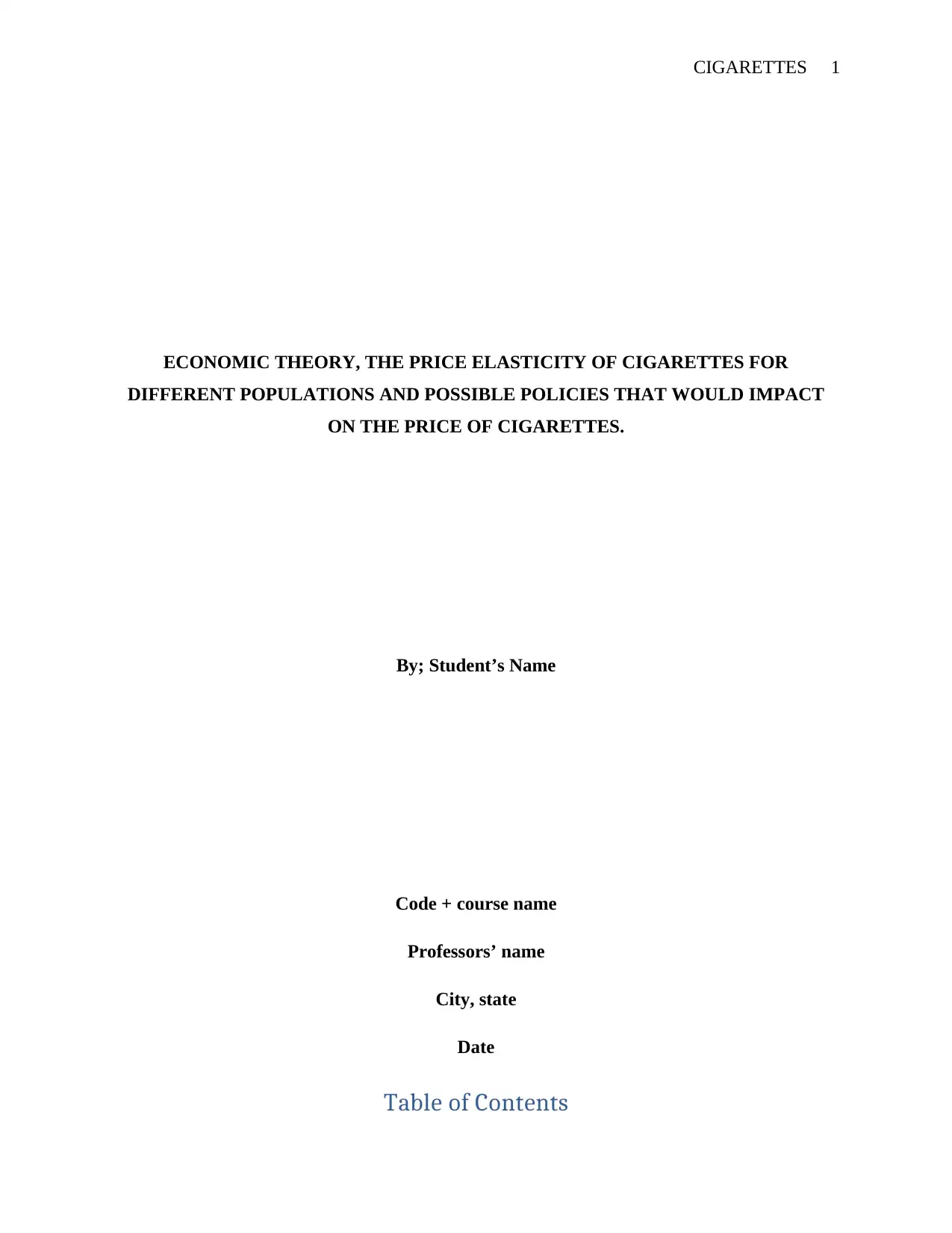
CIGARETTES 1
ECONOMIC THEORY, THE PRICE ELASTICITY OF CIGARETTES FOR
DIFFERENT POPULATIONS AND POSSIBLE POLICIES THAT WOULD IMPACT
ON THE PRICE OF CIGARETTES.
By; Student’s Name
Code + course name
Professors’ name
City, state
Date
Table of Contents
ECONOMIC THEORY, THE PRICE ELASTICITY OF CIGARETTES FOR
DIFFERENT POPULATIONS AND POSSIBLE POLICIES THAT WOULD IMPACT
ON THE PRICE OF CIGARETTES.
By; Student’s Name
Code + course name
Professors’ name
City, state
Date
Table of Contents
Paraphrase This Document
Need a fresh take? Get an instant paraphrase of this document with our AI Paraphraser
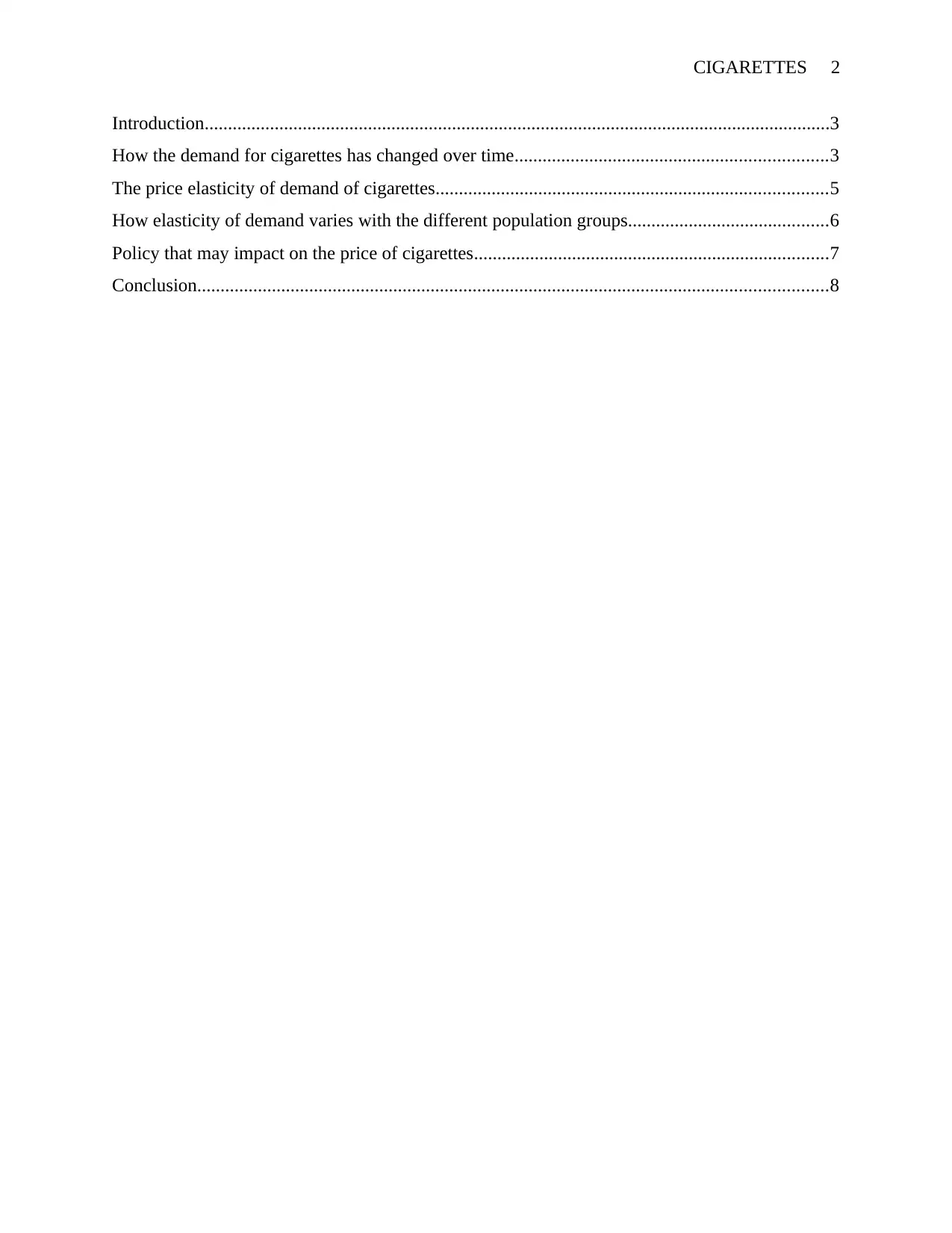
CIGARETTES 2
Introduction......................................................................................................................................3
How the demand for cigarettes has changed over time...................................................................3
The price elasticity of demand of cigarettes....................................................................................5
How elasticity of demand varies with the different population groups...........................................6
Policy that may impact on the price of cigarettes............................................................................7
Conclusion.......................................................................................................................................8
Introduction......................................................................................................................................3
How the demand for cigarettes has changed over time...................................................................3
The price elasticity of demand of cigarettes....................................................................................5
How elasticity of demand varies with the different population groups...........................................6
Policy that may impact on the price of cigarettes............................................................................7
Conclusion.......................................................................................................................................8

CIGARETTES 3
Introduction
Economic theory always has it that the price of a certain good is inversely proportional to its
demand (Armington, 1969). This theory applies to cigarettes. In a majority of population
worldwide, an increase in the price of cigarettes has always led to less demand. In many a
country health economists have proposed to governments to increase taxation on tobacco
products as a measure to regulate the use of the harmful product (Chaloupka et al, 2012). There
is a difference, however, in the way that the various groups of people respond to the increases in
prices. Cigarette price elasticity may vary with gender, economic situation of the country or
individual and age among other factors. Finally, what policies can impact on the price of
cigarettes?
How the demand for cigarettes has changed over time
Although the demand for tobacco products like cigarettes is not as elastic as that of other
consumer products (Tennant, 1950), research has often demonstrated that when the price of
cigarettes increases there occurs moderate falls in the in both the percentage of smokers and the
amount of cigarettes that the remaining smokers consume (World Bank, 1999). The reason for
the decline in this percentage is because, as the International Agency for Research on Cancer
(2011) asserts, increase in the price of cigarettes has the following three effects; it not only
discourages non users from starting, but also encourages continuing users to quit and even more
remarkably discourages former smokers from rejoining the habit.
Researchers use data from the surveys of individuals to determine the impact of price increases
in various countries and regions. In turn they use this statistical data to examine the impact on
both smoking participation (that is, whether people smoke at all) and smoking intensity (that is,
how much people smoke). In their findings, many researchers have come to the conclusion that
increase in cigarette prices has indeed led to lower demand of cigarettes, of course with a
variance vis a vis the various population groups.
Taxation is one of the major ways in which the prices of tobacco and subsequently cigarettes go
up. It has been demonstrated repeatedly that higher taxation has many a time led to a decrease in
demand, and many writers have actually went ahead to propose increase in taxes by governments
in order to reduce the consumption of this dangerous product. With this suggestion though comes
Introduction
Economic theory always has it that the price of a certain good is inversely proportional to its
demand (Armington, 1969). This theory applies to cigarettes. In a majority of population
worldwide, an increase in the price of cigarettes has always led to less demand. In many a
country health economists have proposed to governments to increase taxation on tobacco
products as a measure to regulate the use of the harmful product (Chaloupka et al, 2012). There
is a difference, however, in the way that the various groups of people respond to the increases in
prices. Cigarette price elasticity may vary with gender, economic situation of the country or
individual and age among other factors. Finally, what policies can impact on the price of
cigarettes?
How the demand for cigarettes has changed over time
Although the demand for tobacco products like cigarettes is not as elastic as that of other
consumer products (Tennant, 1950), research has often demonstrated that when the price of
cigarettes increases there occurs moderate falls in the in both the percentage of smokers and the
amount of cigarettes that the remaining smokers consume (World Bank, 1999). The reason for
the decline in this percentage is because, as the International Agency for Research on Cancer
(2011) asserts, increase in the price of cigarettes has the following three effects; it not only
discourages non users from starting, but also encourages continuing users to quit and even more
remarkably discourages former smokers from rejoining the habit.
Researchers use data from the surveys of individuals to determine the impact of price increases
in various countries and regions. In turn they use this statistical data to examine the impact on
both smoking participation (that is, whether people smoke at all) and smoking intensity (that is,
how much people smoke). In their findings, many researchers have come to the conclusion that
increase in cigarette prices has indeed led to lower demand of cigarettes, of course with a
variance vis a vis the various population groups.
Taxation is one of the major ways in which the prices of tobacco and subsequently cigarettes go
up. It has been demonstrated repeatedly that higher taxation has many a time led to a decrease in
demand, and many writers have actually went ahead to propose increase in taxes by governments
in order to reduce the consumption of this dangerous product. With this suggestion though comes
⊘ This is a preview!⊘
Do you want full access?
Subscribe today to unlock all pages.

Trusted by 1+ million students worldwide
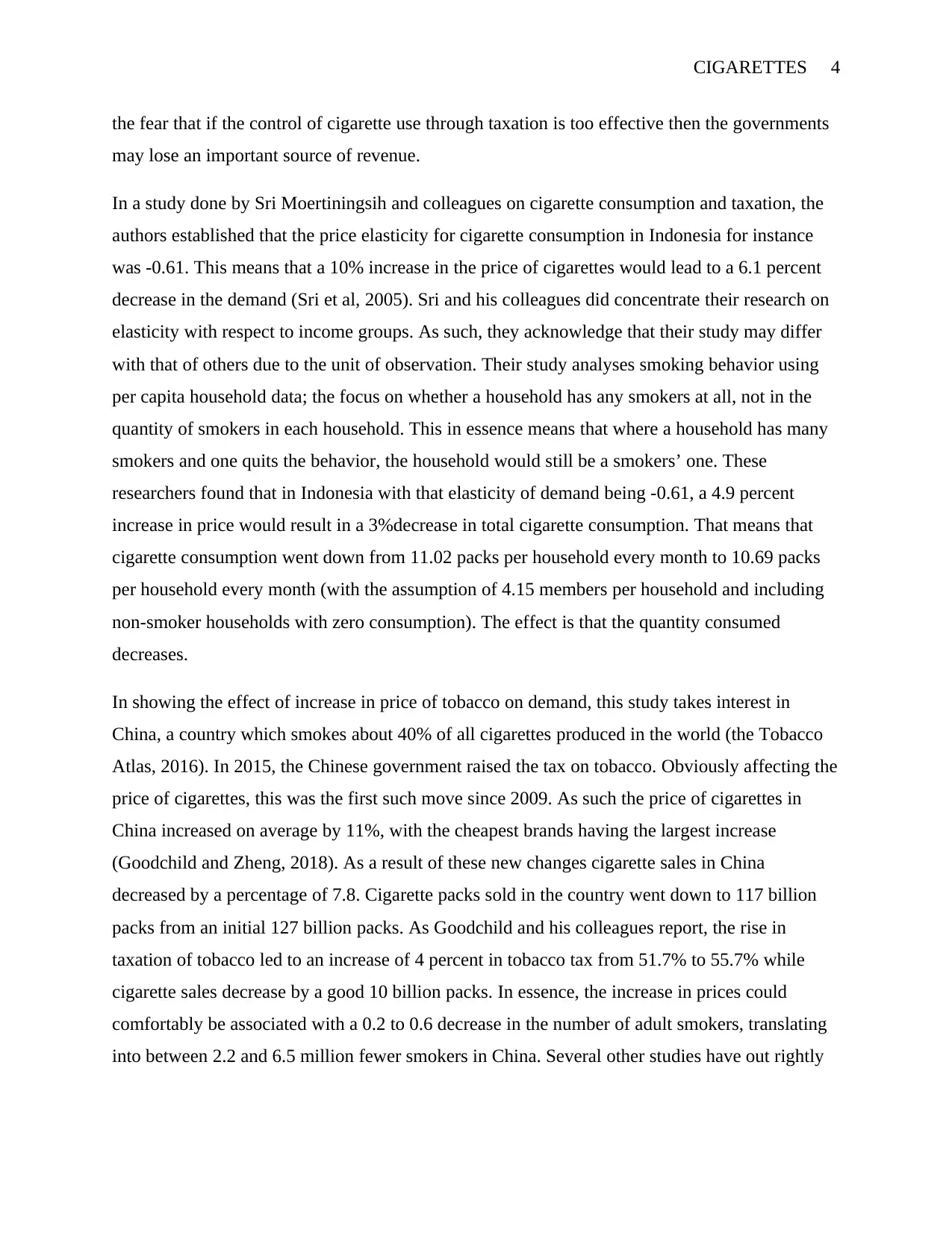
CIGARETTES 4
the fear that if the control of cigarette use through taxation is too effective then the governments
may lose an important source of revenue.
In a study done by Sri Moertiningsih and colleagues on cigarette consumption and taxation, the
authors established that the price elasticity for cigarette consumption in Indonesia for instance
was -0.61. This means that a 10% increase in the price of cigarettes would lead to a 6.1 percent
decrease in the demand (Sri et al, 2005). Sri and his colleagues did concentrate their research on
elasticity with respect to income groups. As such, they acknowledge that their study may differ
with that of others due to the unit of observation. Their study analyses smoking behavior using
per capita household data; the focus on whether a household has any smokers at all, not in the
quantity of smokers in each household. This in essence means that where a household has many
smokers and one quits the behavior, the household would still be a smokers’ one. These
researchers found that in Indonesia with that elasticity of demand being -0.61, a 4.9 percent
increase in price would result in a 3%decrease in total cigarette consumption. That means that
cigarette consumption went down from 11.02 packs per household every month to 10.69 packs
per household every month (with the assumption of 4.15 members per household and including
non-smoker households with zero consumption). The effect is that the quantity consumed
decreases.
In showing the effect of increase in price of tobacco on demand, this study takes interest in
China, a country which smokes about 40% of all cigarettes produced in the world (the Tobacco
Atlas, 2016). In 2015, the Chinese government raised the tax on tobacco. Obviously affecting the
price of cigarettes, this was the first such move since 2009. As such the price of cigarettes in
China increased on average by 11%, with the cheapest brands having the largest increase
(Goodchild and Zheng, 2018). As a result of these new changes cigarette sales in China
decreased by a percentage of 7.8. Cigarette packs sold in the country went down to 117 billion
packs from an initial 127 billion packs. As Goodchild and his colleagues report, the rise in
taxation of tobacco led to an increase of 4 percent in tobacco tax from 51.7% to 55.7% while
cigarette sales decrease by a good 10 billion packs. In essence, the increase in prices could
comfortably be associated with a 0.2 to 0.6 decrease in the number of adult smokers, translating
into between 2.2 and 6.5 million fewer smokers in China. Several other studies have out rightly
the fear that if the control of cigarette use through taxation is too effective then the governments
may lose an important source of revenue.
In a study done by Sri Moertiningsih and colleagues on cigarette consumption and taxation, the
authors established that the price elasticity for cigarette consumption in Indonesia for instance
was -0.61. This means that a 10% increase in the price of cigarettes would lead to a 6.1 percent
decrease in the demand (Sri et al, 2005). Sri and his colleagues did concentrate their research on
elasticity with respect to income groups. As such, they acknowledge that their study may differ
with that of others due to the unit of observation. Their study analyses smoking behavior using
per capita household data; the focus on whether a household has any smokers at all, not in the
quantity of smokers in each household. This in essence means that where a household has many
smokers and one quits the behavior, the household would still be a smokers’ one. These
researchers found that in Indonesia with that elasticity of demand being -0.61, a 4.9 percent
increase in price would result in a 3%decrease in total cigarette consumption. That means that
cigarette consumption went down from 11.02 packs per household every month to 10.69 packs
per household every month (with the assumption of 4.15 members per household and including
non-smoker households with zero consumption). The effect is that the quantity consumed
decreases.
In showing the effect of increase in price of tobacco on demand, this study takes interest in
China, a country which smokes about 40% of all cigarettes produced in the world (the Tobacco
Atlas, 2016). In 2015, the Chinese government raised the tax on tobacco. Obviously affecting the
price of cigarettes, this was the first such move since 2009. As such the price of cigarettes in
China increased on average by 11%, with the cheapest brands having the largest increase
(Goodchild and Zheng, 2018). As a result of these new changes cigarette sales in China
decreased by a percentage of 7.8. Cigarette packs sold in the country went down to 117 billion
packs from an initial 127 billion packs. As Goodchild and his colleagues report, the rise in
taxation of tobacco led to an increase of 4 percent in tobacco tax from 51.7% to 55.7% while
cigarette sales decrease by a good 10 billion packs. In essence, the increase in prices could
comfortably be associated with a 0.2 to 0.6 decrease in the number of adult smokers, translating
into between 2.2 and 6.5 million fewer smokers in China. Several other studies have out rightly
Paraphrase This Document
Need a fresh take? Get an instant paraphrase of this document with our AI Paraphraser
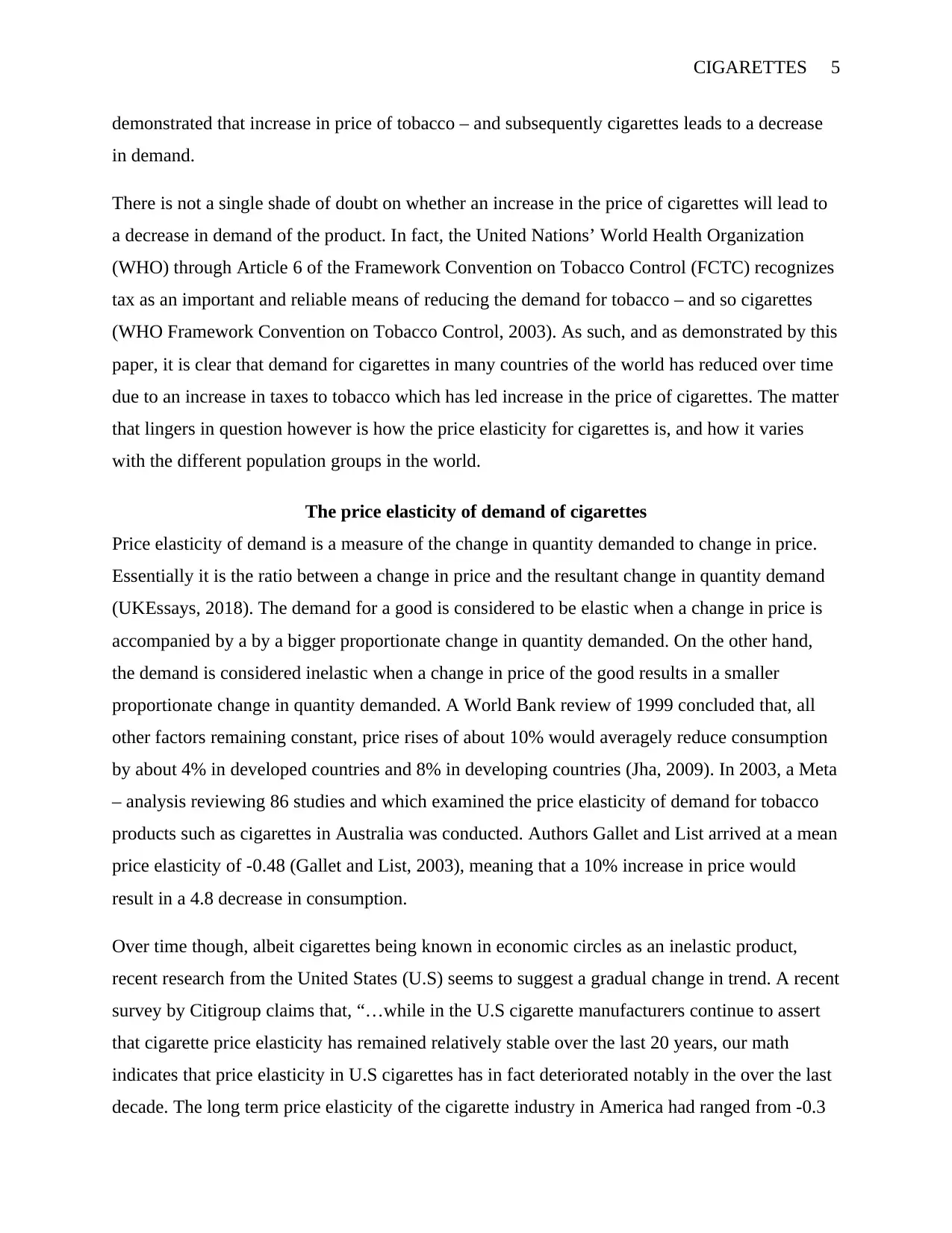
CIGARETTES 5
demonstrated that increase in price of tobacco – and subsequently cigarettes leads to a decrease
in demand.
There is not a single shade of doubt on whether an increase in the price of cigarettes will lead to
a decrease in demand of the product. In fact, the United Nations’ World Health Organization
(WHO) through Article 6 of the Framework Convention on Tobacco Control (FCTC) recognizes
tax as an important and reliable means of reducing the demand for tobacco – and so cigarettes
(WHO Framework Convention on Tobacco Control, 2003). As such, and as demonstrated by this
paper, it is clear that demand for cigarettes in many countries of the world has reduced over time
due to an increase in taxes to tobacco which has led increase in the price of cigarettes. The matter
that lingers in question however is how the price elasticity for cigarettes is, and how it varies
with the different population groups in the world.
The price elasticity of demand of cigarettes
Price elasticity of demand is a measure of the change in quantity demanded to change in price.
Essentially it is the ratio between a change in price and the resultant change in quantity demand
(UKEssays, 2018). The demand for a good is considered to be elastic when a change in price is
accompanied by a by a bigger proportionate change in quantity demanded. On the other hand,
the demand is considered inelastic when a change in price of the good results in a smaller
proportionate change in quantity demanded. A World Bank review of 1999 concluded that, all
other factors remaining constant, price rises of about 10% would averagely reduce consumption
by about 4% in developed countries and 8% in developing countries (Jha, 2009). In 2003, a Meta
– analysis reviewing 86 studies and which examined the price elasticity of demand for tobacco
products such as cigarettes in Australia was conducted. Authors Gallet and List arrived at a mean
price elasticity of -0.48 (Gallet and List, 2003), meaning that a 10% increase in price would
result in a 4.8 decrease in consumption.
Over time though, albeit cigarettes being known in economic circles as an inelastic product,
recent research from the United States (U.S) seems to suggest a gradual change in trend. A recent
survey by Citigroup claims that, “…while in the U.S cigarette manufacturers continue to assert
that cigarette price elasticity has remained relatively stable over the last 20 years, our math
indicates that price elasticity in U.S cigarettes has in fact deteriorated notably in the over the last
decade. The long term price elasticity of the cigarette industry in America had ranged from -0.3
demonstrated that increase in price of tobacco – and subsequently cigarettes leads to a decrease
in demand.
There is not a single shade of doubt on whether an increase in the price of cigarettes will lead to
a decrease in demand of the product. In fact, the United Nations’ World Health Organization
(WHO) through Article 6 of the Framework Convention on Tobacco Control (FCTC) recognizes
tax as an important and reliable means of reducing the demand for tobacco – and so cigarettes
(WHO Framework Convention on Tobacco Control, 2003). As such, and as demonstrated by this
paper, it is clear that demand for cigarettes in many countries of the world has reduced over time
due to an increase in taxes to tobacco which has led increase in the price of cigarettes. The matter
that lingers in question however is how the price elasticity for cigarettes is, and how it varies
with the different population groups in the world.
The price elasticity of demand of cigarettes
Price elasticity of demand is a measure of the change in quantity demanded to change in price.
Essentially it is the ratio between a change in price and the resultant change in quantity demand
(UKEssays, 2018). The demand for a good is considered to be elastic when a change in price is
accompanied by a by a bigger proportionate change in quantity demanded. On the other hand,
the demand is considered inelastic when a change in price of the good results in a smaller
proportionate change in quantity demanded. A World Bank review of 1999 concluded that, all
other factors remaining constant, price rises of about 10% would averagely reduce consumption
by about 4% in developed countries and 8% in developing countries (Jha, 2009). In 2003, a Meta
– analysis reviewing 86 studies and which examined the price elasticity of demand for tobacco
products such as cigarettes in Australia was conducted. Authors Gallet and List arrived at a mean
price elasticity of -0.48 (Gallet and List, 2003), meaning that a 10% increase in price would
result in a 4.8 decrease in consumption.
Over time though, albeit cigarettes being known in economic circles as an inelastic product,
recent research from the United States (U.S) seems to suggest a gradual change in trend. A recent
survey by Citigroup claims that, “…while in the U.S cigarette manufacturers continue to assert
that cigarette price elasticity has remained relatively stable over the last 20 years, our math
indicates that price elasticity in U.S cigarettes has in fact deteriorated notably in the over the last
decade. The long term price elasticity of the cigarette industry in America had ranged from -0.3
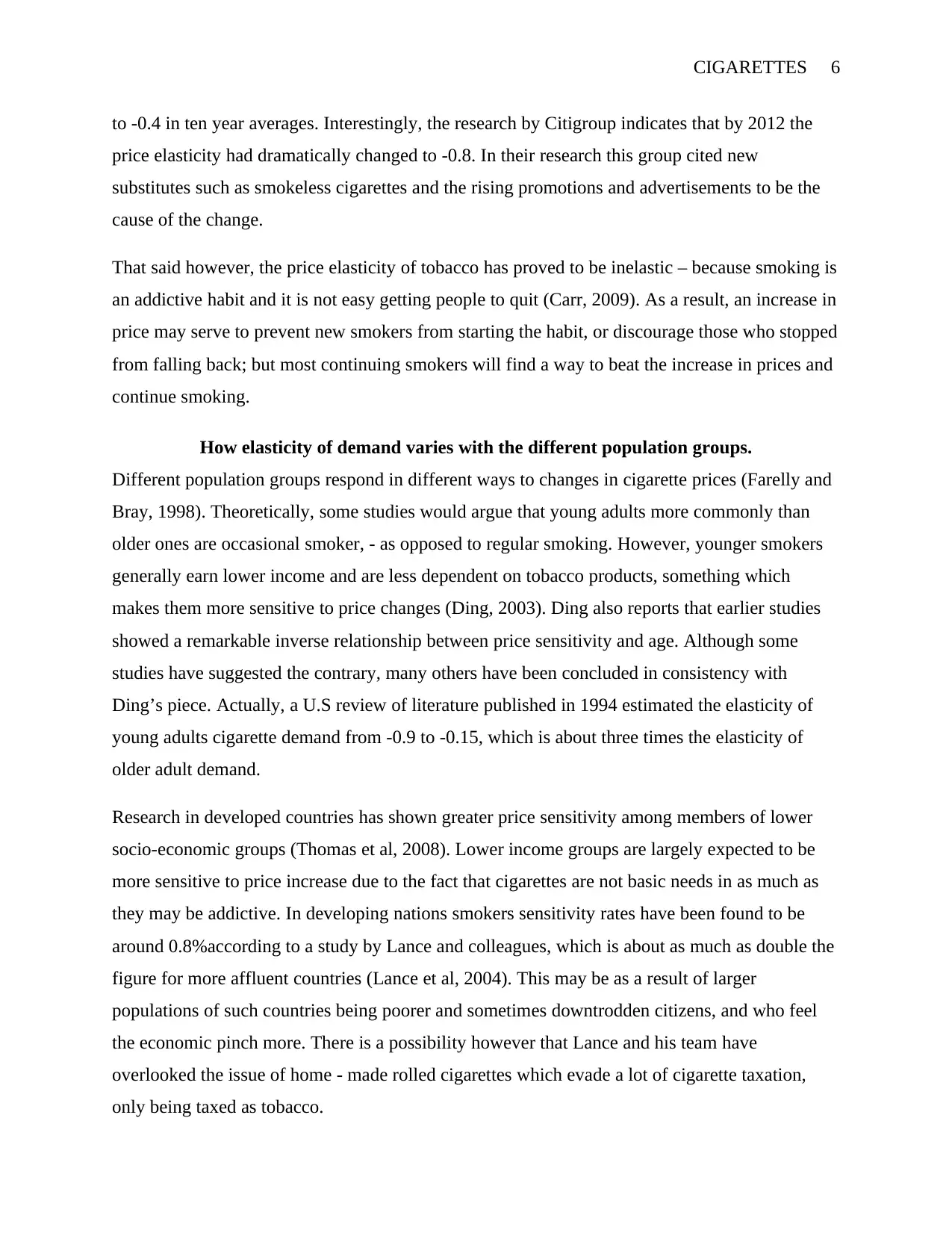
CIGARETTES 6
to -0.4 in ten year averages. Interestingly, the research by Citigroup indicates that by 2012 the
price elasticity had dramatically changed to -0.8. In their research this group cited new
substitutes such as smokeless cigarettes and the rising promotions and advertisements to be the
cause of the change.
That said however, the price elasticity of tobacco has proved to be inelastic – because smoking is
an addictive habit and it is not easy getting people to quit (Carr, 2009). As a result, an increase in
price may serve to prevent new smokers from starting the habit, or discourage those who stopped
from falling back; but most continuing smokers will find a way to beat the increase in prices and
continue smoking.
How elasticity of demand varies with the different population groups.
Different population groups respond in different ways to changes in cigarette prices (Farelly and
Bray, 1998). Theoretically, some studies would argue that young adults more commonly than
older ones are occasional smoker, - as opposed to regular smoking. However, younger smokers
generally earn lower income and are less dependent on tobacco products, something which
makes them more sensitive to price changes (Ding, 2003). Ding also reports that earlier studies
showed a remarkable inverse relationship between price sensitivity and age. Although some
studies have suggested the contrary, many others have been concluded in consistency with
Ding’s piece. Actually, a U.S review of literature published in 1994 estimated the elasticity of
young adults cigarette demand from -0.9 to -0.15, which is about three times the elasticity of
older adult demand.
Research in developed countries has shown greater price sensitivity among members of lower
socio-economic groups (Thomas et al, 2008). Lower income groups are largely expected to be
more sensitive to price increase due to the fact that cigarettes are not basic needs in as much as
they may be addictive. In developing nations smokers sensitivity rates have been found to be
around 0.8%according to a study by Lance and colleagues, which is about as much as double the
figure for more affluent countries (Lance et al, 2004). This may be as a result of larger
populations of such countries being poorer and sometimes downtrodden citizens, and who feel
the economic pinch more. There is a possibility however that Lance and his team have
overlooked the issue of home - made rolled cigarettes which evade a lot of cigarette taxation,
only being taxed as tobacco.
to -0.4 in ten year averages. Interestingly, the research by Citigroup indicates that by 2012 the
price elasticity had dramatically changed to -0.8. In their research this group cited new
substitutes such as smokeless cigarettes and the rising promotions and advertisements to be the
cause of the change.
That said however, the price elasticity of tobacco has proved to be inelastic – because smoking is
an addictive habit and it is not easy getting people to quit (Carr, 2009). As a result, an increase in
price may serve to prevent new smokers from starting the habit, or discourage those who stopped
from falling back; but most continuing smokers will find a way to beat the increase in prices and
continue smoking.
How elasticity of demand varies with the different population groups.
Different population groups respond in different ways to changes in cigarette prices (Farelly and
Bray, 1998). Theoretically, some studies would argue that young adults more commonly than
older ones are occasional smoker, - as opposed to regular smoking. However, younger smokers
generally earn lower income and are less dependent on tobacco products, something which
makes them more sensitive to price changes (Ding, 2003). Ding also reports that earlier studies
showed a remarkable inverse relationship between price sensitivity and age. Although some
studies have suggested the contrary, many others have been concluded in consistency with
Ding’s piece. Actually, a U.S review of literature published in 1994 estimated the elasticity of
young adults cigarette demand from -0.9 to -0.15, which is about three times the elasticity of
older adult demand.
Research in developed countries has shown greater price sensitivity among members of lower
socio-economic groups (Thomas et al, 2008). Lower income groups are largely expected to be
more sensitive to price increase due to the fact that cigarettes are not basic needs in as much as
they may be addictive. In developing nations smokers sensitivity rates have been found to be
around 0.8%according to a study by Lance and colleagues, which is about as much as double the
figure for more affluent countries (Lance et al, 2004). This may be as a result of larger
populations of such countries being poorer and sometimes downtrodden citizens, and who feel
the economic pinch more. There is a possibility however that Lance and his team have
overlooked the issue of home - made rolled cigarettes which evade a lot of cigarette taxation,
only being taxed as tobacco.
⊘ This is a preview!⊘
Do you want full access?
Subscribe today to unlock all pages.

Trusted by 1+ million students worldwide
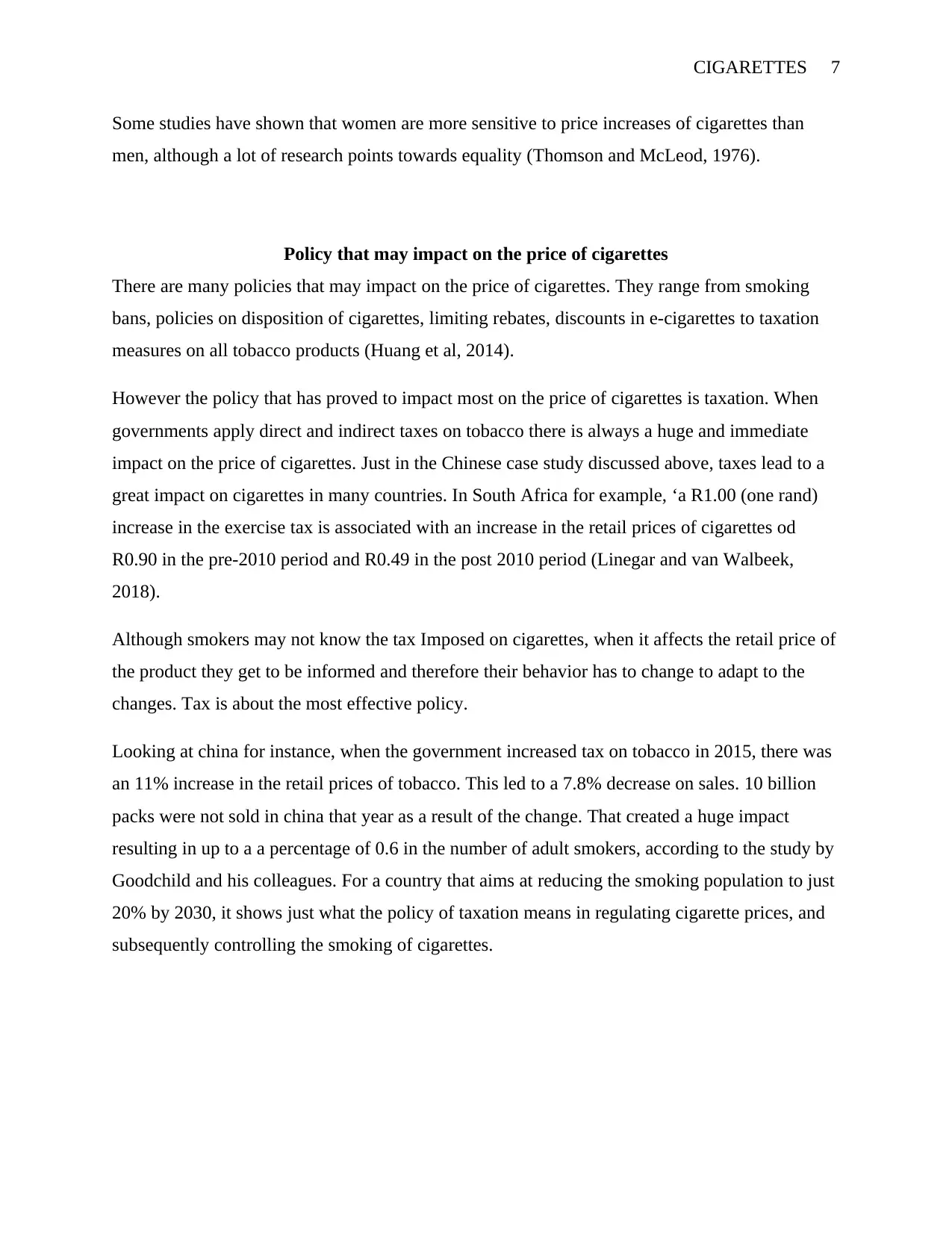
CIGARETTES 7
Some studies have shown that women are more sensitive to price increases of cigarettes than
men, although a lot of research points towards equality (Thomson and McLeod, 1976).
Policy that may impact on the price of cigarettes
There are many policies that may impact on the price of cigarettes. They range from smoking
bans, policies on disposition of cigarettes, limiting rebates, discounts in e-cigarettes to taxation
measures on all tobacco products (Huang et al, 2014).
However the policy that has proved to impact most on the price of cigarettes is taxation. When
governments apply direct and indirect taxes on tobacco there is always a huge and immediate
impact on the price of cigarettes. Just in the Chinese case study discussed above, taxes lead to a
great impact on cigarettes in many countries. In South Africa for example, ‘a R1.00 (one rand)
increase in the exercise tax is associated with an increase in the retail prices of cigarettes od
R0.90 in the pre-2010 period and R0.49 in the post 2010 period (Linegar and van Walbeek,
2018).
Although smokers may not know the tax Imposed on cigarettes, when it affects the retail price of
the product they get to be informed and therefore their behavior has to change to adapt to the
changes. Tax is about the most effective policy.
Looking at china for instance, when the government increased tax on tobacco in 2015, there was
an 11% increase in the retail prices of tobacco. This led to a 7.8% decrease on sales. 10 billion
packs were not sold in china that year as a result of the change. That created a huge impact
resulting in up to a a percentage of 0.6 in the number of adult smokers, according to the study by
Goodchild and his colleagues. For a country that aims at reducing the smoking population to just
20% by 2030, it shows just what the policy of taxation means in regulating cigarette prices, and
subsequently controlling the smoking of cigarettes.
Some studies have shown that women are more sensitive to price increases of cigarettes than
men, although a lot of research points towards equality (Thomson and McLeod, 1976).
Policy that may impact on the price of cigarettes
There are many policies that may impact on the price of cigarettes. They range from smoking
bans, policies on disposition of cigarettes, limiting rebates, discounts in e-cigarettes to taxation
measures on all tobacco products (Huang et al, 2014).
However the policy that has proved to impact most on the price of cigarettes is taxation. When
governments apply direct and indirect taxes on tobacco there is always a huge and immediate
impact on the price of cigarettes. Just in the Chinese case study discussed above, taxes lead to a
great impact on cigarettes in many countries. In South Africa for example, ‘a R1.00 (one rand)
increase in the exercise tax is associated with an increase in the retail prices of cigarettes od
R0.90 in the pre-2010 period and R0.49 in the post 2010 period (Linegar and van Walbeek,
2018).
Although smokers may not know the tax Imposed on cigarettes, when it affects the retail price of
the product they get to be informed and therefore their behavior has to change to adapt to the
changes. Tax is about the most effective policy.
Looking at china for instance, when the government increased tax on tobacco in 2015, there was
an 11% increase in the retail prices of tobacco. This led to a 7.8% decrease on sales. 10 billion
packs were not sold in china that year as a result of the change. That created a huge impact
resulting in up to a a percentage of 0.6 in the number of adult smokers, according to the study by
Goodchild and his colleagues. For a country that aims at reducing the smoking population to just
20% by 2030, it shows just what the policy of taxation means in regulating cigarette prices, and
subsequently controlling the smoking of cigarettes.
Paraphrase This Document
Need a fresh take? Get an instant paraphrase of this document with our AI Paraphraser
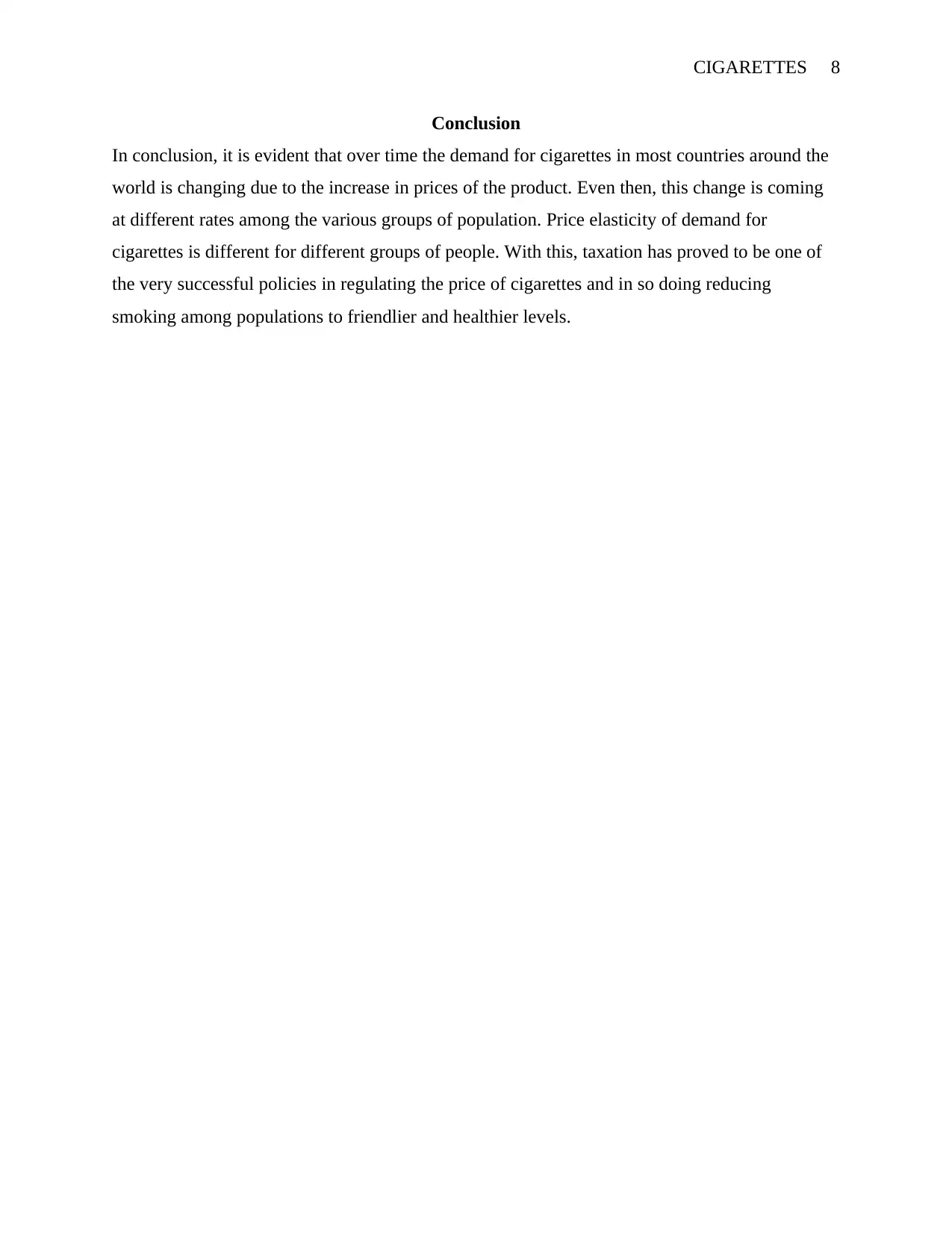
CIGARETTES 8
Conclusion
In conclusion, it is evident that over time the demand for cigarettes in most countries around the
world is changing due to the increase in prices of the product. Even then, this change is coming
at different rates among the various groups of population. Price elasticity of demand for
cigarettes is different for different groups of people. With this, taxation has proved to be one of
the very successful policies in regulating the price of cigarettes and in so doing reducing
smoking among populations to friendlier and healthier levels.
Conclusion
In conclusion, it is evident that over time the demand for cigarettes in most countries around the
world is changing due to the increase in prices of the product. Even then, this change is coming
at different rates among the various groups of population. Price elasticity of demand for
cigarettes is different for different groups of people. With this, taxation has proved to be one of
the very successful policies in regulating the price of cigarettes and in so doing reducing
smoking among populations to friendlier and healthier levels.
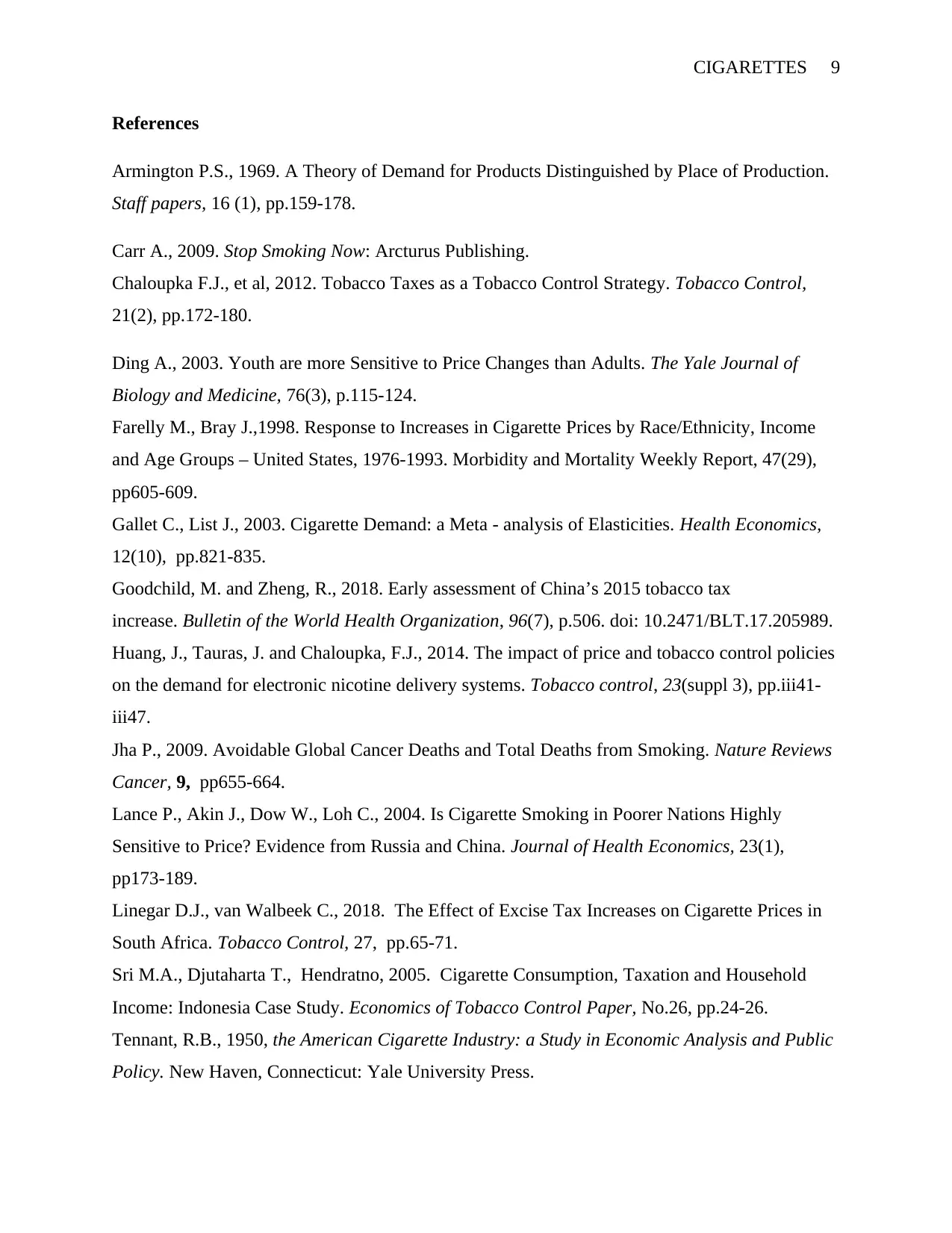
CIGARETTES 9
References
Armington P.S., 1969. A Theory of Demand for Products Distinguished by Place of Production.
Staff papers, 16 (1), pp.159-178.
Carr A., 2009. Stop Smoking Now: Arcturus Publishing.
Chaloupka F.J., et al, 2012. Tobacco Taxes as a Tobacco Control Strategy. Tobacco Control,
21(2), pp.172-180.
Ding A., 2003. Youth are more Sensitive to Price Changes than Adults. The Yale Journal of
Biology and Medicine, 76(3), p.115-124.
Farelly M., Bray J.,1998. Response to Increases in Cigarette Prices by Race/Ethnicity, Income
and Age Groups – United States, 1976-1993. Morbidity and Mortality Weekly Report, 47(29),
pp605-609.
Gallet C., List J., 2003. Cigarette Demand: a Meta - analysis of Elasticities. Health Economics,
12(10), pp.821-835.
Goodchild, M. and Zheng, R., 2018. Early assessment of China’s 2015 tobacco tax
increase. Bulletin of the World Health Organization, 96(7), p.506. doi: 10.2471/BLT.17.205989.
Huang, J., Tauras, J. and Chaloupka, F.J., 2014. The impact of price and tobacco control policies
on the demand for electronic nicotine delivery systems. Tobacco control, 23(suppl 3), pp.iii41-
iii47.
Jha P., 2009. Avoidable Global Cancer Deaths and Total Deaths from Smoking. Nature Reviews
Cancer, 9, pp655-664.
Lance P., Akin J., Dow W., Loh C., 2004. Is Cigarette Smoking in Poorer Nations Highly
Sensitive to Price? Evidence from Russia and China. Journal of Health Economics, 23(1),
pp173-189.
Linegar D.J., van Walbeek C., 2018. The Effect of Excise Tax Increases on Cigarette Prices in
South Africa. Tobacco Control, 27, pp.65-71.
Sri M.A., Djutaharta T., Hendratno, 2005. Cigarette Consumption, Taxation and Household
Income: Indonesia Case Study. Economics of Tobacco Control Paper, No.26, pp.24-26.
Tennant, R.B., 1950, the American Cigarette Industry: a Study in Economic Analysis and Public
Policy. New Haven, Connecticut: Yale University Press.
References
Armington P.S., 1969. A Theory of Demand for Products Distinguished by Place of Production.
Staff papers, 16 (1), pp.159-178.
Carr A., 2009. Stop Smoking Now: Arcturus Publishing.
Chaloupka F.J., et al, 2012. Tobacco Taxes as a Tobacco Control Strategy. Tobacco Control,
21(2), pp.172-180.
Ding A., 2003. Youth are more Sensitive to Price Changes than Adults. The Yale Journal of
Biology and Medicine, 76(3), p.115-124.
Farelly M., Bray J.,1998. Response to Increases in Cigarette Prices by Race/Ethnicity, Income
and Age Groups – United States, 1976-1993. Morbidity and Mortality Weekly Report, 47(29),
pp605-609.
Gallet C., List J., 2003. Cigarette Demand: a Meta - analysis of Elasticities. Health Economics,
12(10), pp.821-835.
Goodchild, M. and Zheng, R., 2018. Early assessment of China’s 2015 tobacco tax
increase. Bulletin of the World Health Organization, 96(7), p.506. doi: 10.2471/BLT.17.205989.
Huang, J., Tauras, J. and Chaloupka, F.J., 2014. The impact of price and tobacco control policies
on the demand for electronic nicotine delivery systems. Tobacco control, 23(suppl 3), pp.iii41-
iii47.
Jha P., 2009. Avoidable Global Cancer Deaths and Total Deaths from Smoking. Nature Reviews
Cancer, 9, pp655-664.
Lance P., Akin J., Dow W., Loh C., 2004. Is Cigarette Smoking in Poorer Nations Highly
Sensitive to Price? Evidence from Russia and China. Journal of Health Economics, 23(1),
pp173-189.
Linegar D.J., van Walbeek C., 2018. The Effect of Excise Tax Increases on Cigarette Prices in
South Africa. Tobacco Control, 27, pp.65-71.
Sri M.A., Djutaharta T., Hendratno, 2005. Cigarette Consumption, Taxation and Household
Income: Indonesia Case Study. Economics of Tobacco Control Paper, No.26, pp.24-26.
Tennant, R.B., 1950, the American Cigarette Industry: a Study in Economic Analysis and Public
Policy. New Haven, Connecticut: Yale University Press.
⊘ This is a preview!⊘
Do you want full access?
Subscribe today to unlock all pages.

Trusted by 1+ million students worldwide
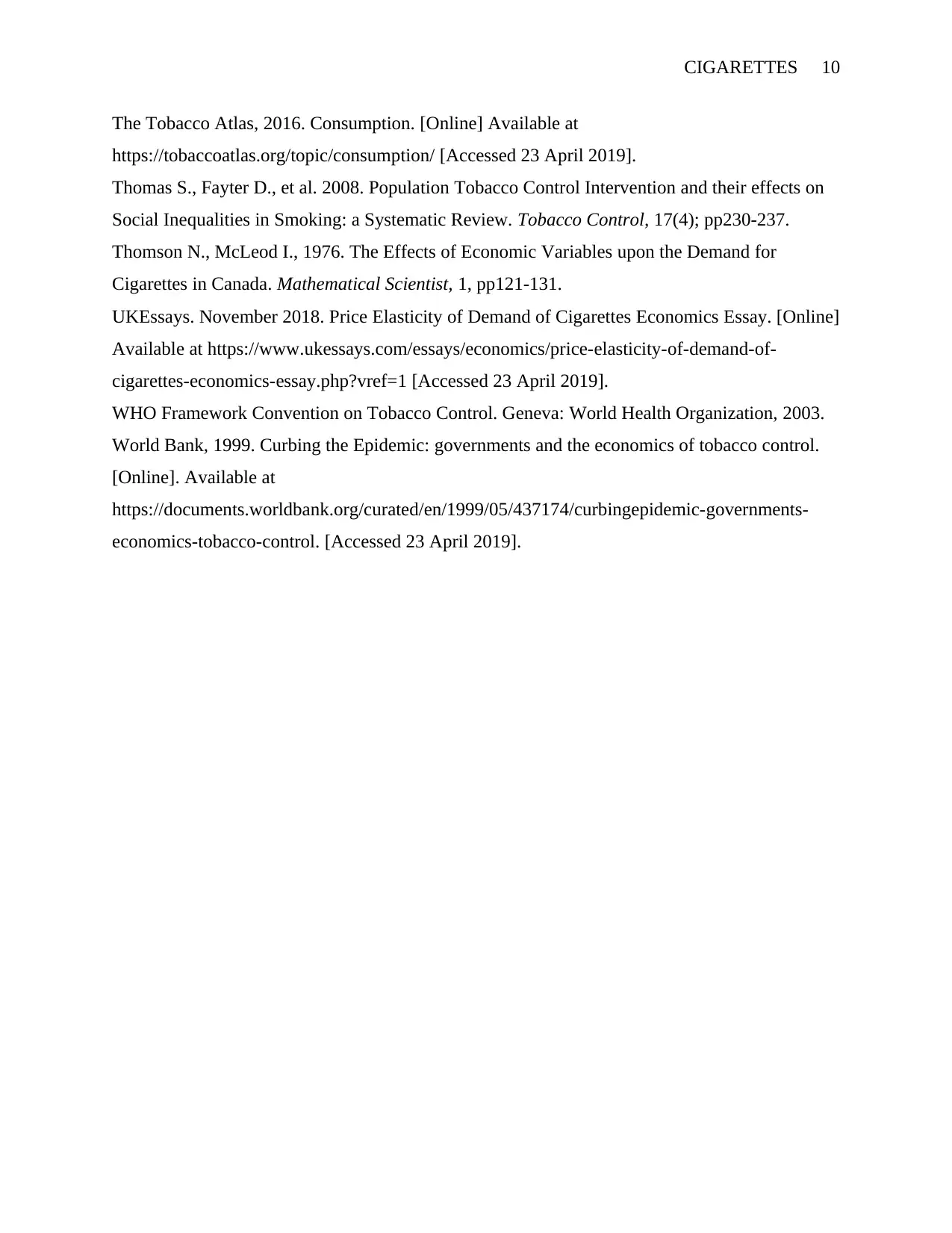
CIGARETTES 10
The Tobacco Atlas, 2016. Consumption. [Online] Available at
https://tobaccoatlas.org/topic/consumption/ [Accessed 23 April 2019].
Thomas S., Fayter D., et al. 2008. Population Tobacco Control Intervention and their effects on
Social Inequalities in Smoking: a Systematic Review. Tobacco Control, 17(4); pp230-237.
Thomson N., McLeod I., 1976. The Effects of Economic Variables upon the Demand for
Cigarettes in Canada. Mathematical Scientist, 1, pp121-131.
UKEssays. November 2018. Price Elasticity of Demand of Cigarettes Economics Essay. [Online]
Available at https://www.ukessays.com/essays/economics/price-elasticity-of-demand-of-
cigarettes-economics-essay.php?vref=1 [Accessed 23 April 2019].
WHO Framework Convention on Tobacco Control. Geneva: World Health Organization, 2003.
World Bank, 1999. Curbing the Epidemic: governments and the economics of tobacco control.
[Online]. Available at
https://documents.worldbank.org/curated/en/1999/05/437174/curbingepidemic-governments-
economics-tobacco-control. [Accessed 23 April 2019].
The Tobacco Atlas, 2016. Consumption. [Online] Available at
https://tobaccoatlas.org/topic/consumption/ [Accessed 23 April 2019].
Thomas S., Fayter D., et al. 2008. Population Tobacco Control Intervention and their effects on
Social Inequalities in Smoking: a Systematic Review. Tobacco Control, 17(4); pp230-237.
Thomson N., McLeod I., 1976. The Effects of Economic Variables upon the Demand for
Cigarettes in Canada. Mathematical Scientist, 1, pp121-131.
UKEssays. November 2018. Price Elasticity of Demand of Cigarettes Economics Essay. [Online]
Available at https://www.ukessays.com/essays/economics/price-elasticity-of-demand-of-
cigarettes-economics-essay.php?vref=1 [Accessed 23 April 2019].
WHO Framework Convention on Tobacco Control. Geneva: World Health Organization, 2003.
World Bank, 1999. Curbing the Epidemic: governments and the economics of tobacco control.
[Online]. Available at
https://documents.worldbank.org/curated/en/1999/05/437174/curbingepidemic-governments-
economics-tobacco-control. [Accessed 23 April 2019].
1 out of 10
Related Documents
Your All-in-One AI-Powered Toolkit for Academic Success.
+13062052269
info@desklib.com
Available 24*7 on WhatsApp / Email
![[object Object]](/_next/static/media/star-bottom.7253800d.svg)
Unlock your academic potential
Copyright © 2020–2025 A2Z Services. All Rights Reserved. Developed and managed by ZUCOL.





